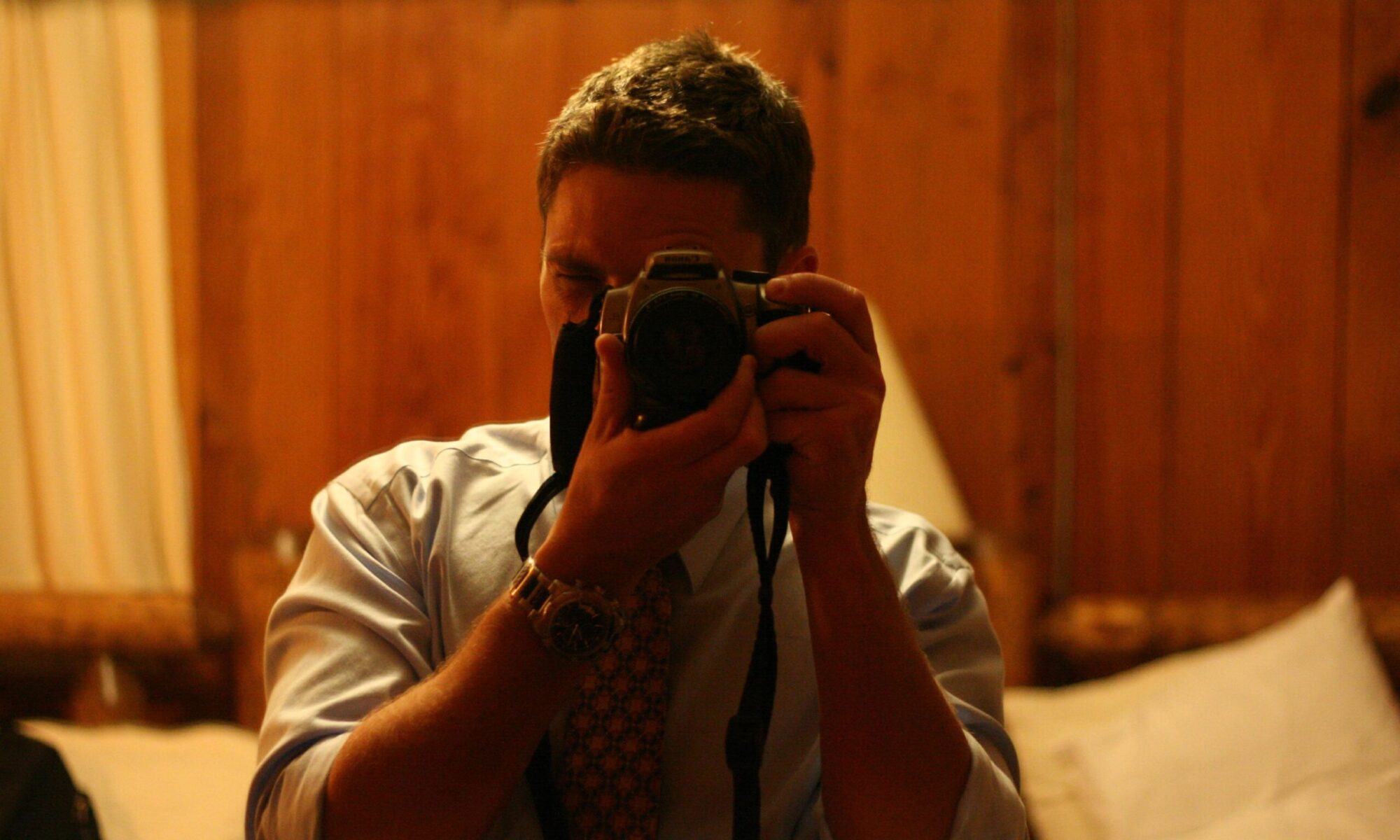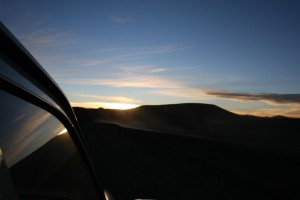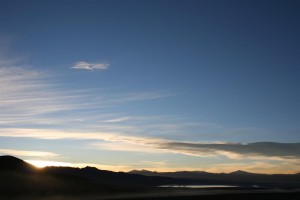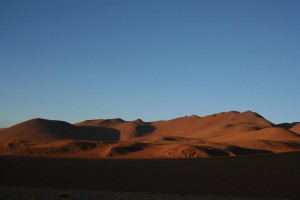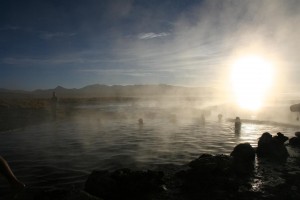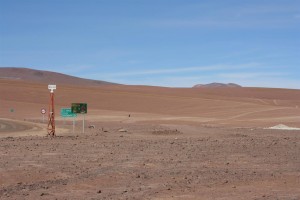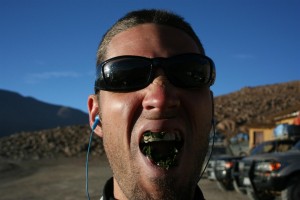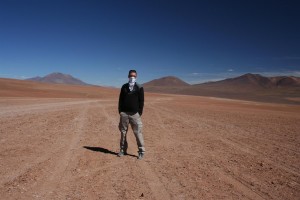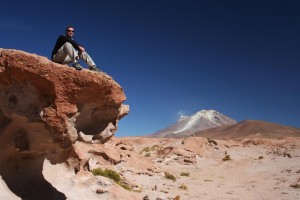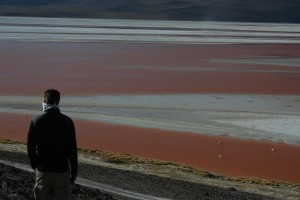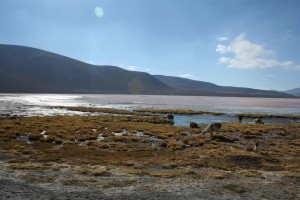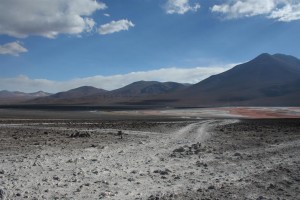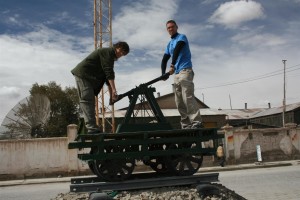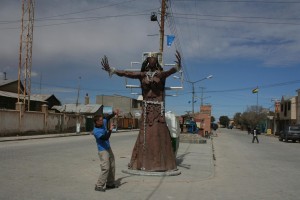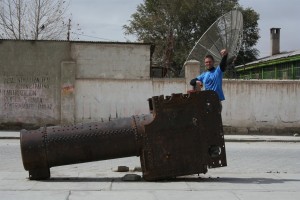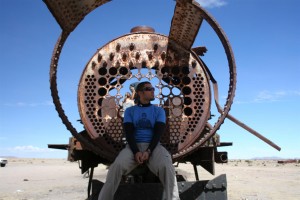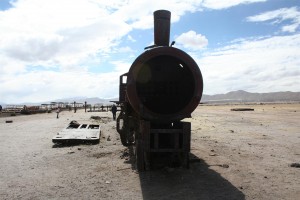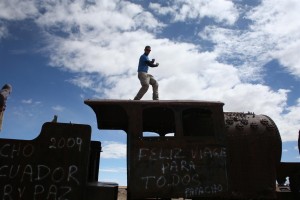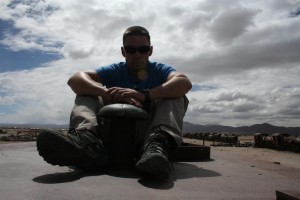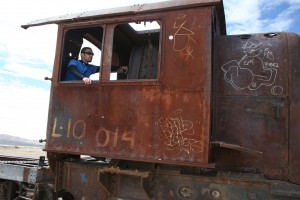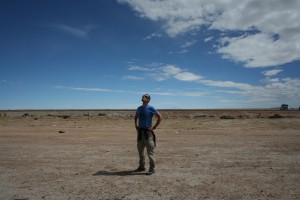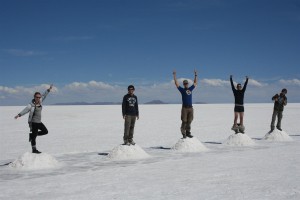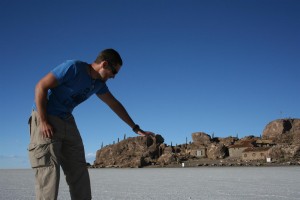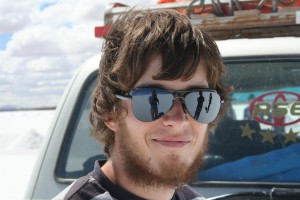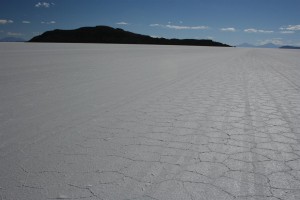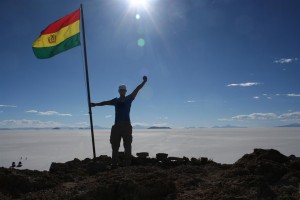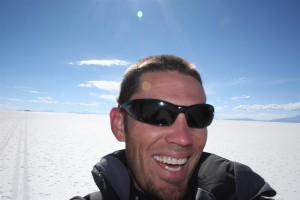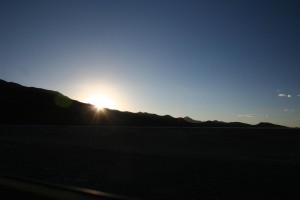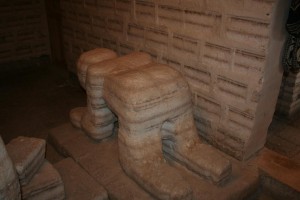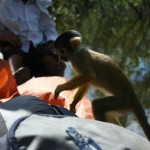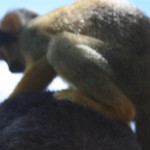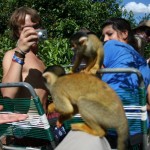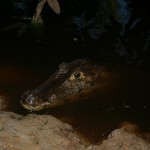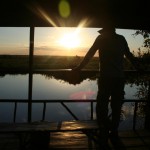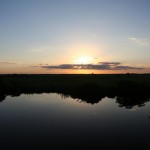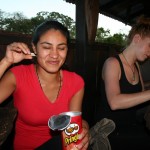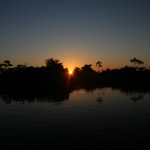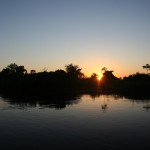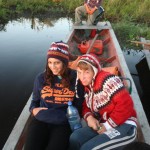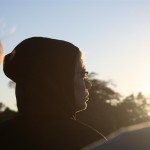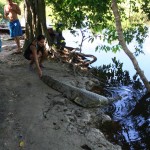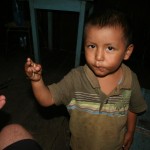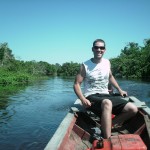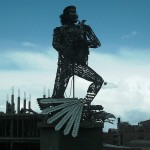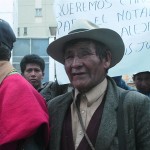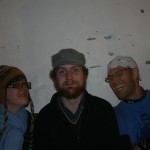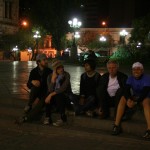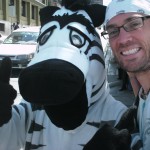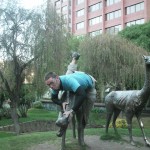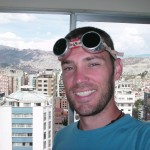Rurrenebaque is the best part of Bolivia. Aside from dynamite, because dynamite is just all around excellent.
This includes the surrounding jungles and is, of course, a sweeping generalization. Getting to Rurrenebaque is rather easy from La Paz if you are willing to invest either the time or money; 20 hours on a bus, or$ 60-75 USD for the plane. Two companies fly on specific days, TAM and Amaszonas, and are often canceled due to weather so Amaszonas is your best bet, with 4 flights daily, if you are on a tight schedule. Their office address is not listed in the Lonely Planet, but they have English speaking staff and are located at 1649 Avenia Saavendras in the Miraflores district.
The plane is something of a flying machine with egg crate seats inside one seat to each side of the tiny aisle with no head or leg room. Luckily it is barely an hour flight. Getting off the plane at the “airport,” read as large grass field, was a very rewarding experience. Leaving the cold and altitude of La Paz for the blessed warmth and 300 meter elevation of Rurre was enough to put a smile on my face. The fact that there were almost zero taxis as well was even better. Grab the Amaszonas shuttle into town for 6 bolivianos; the mototaxis are madmen and everyone knows two men on the same motorcycle are gay.
Once you get into town, have a blast! As soon as I arrived in Rurre, I took off to find a hostel and a tour group. Walking through town I saw many questionable places to stay, but just as many that had beautiful courtyards, perfectly clean rooms and hot water. If you get off the bus and take a left, walking due west, you will get to the only park in town. I stayed across that park at Hostel Oriental. Nice place, all in all.
After I checked in to my room, I came out front to ask the owner about tour companies. Instead, I met the second Argentinian I had ever encountered; Evelyn.
After some brief conversation with the owner of the hotel, the two of us decided to take off and go for a hike to one of the miradors overlooking the jungle and city. It wasn’t a cakewalk. The hike was it’s own reward and the view was quite nice. At the top, we ran into a couple of German girls, Monique and Anika, and decided with strength in numbers to go hunting a tour into the wild for the following day.
Rurrenebaque is not an easy town to get lost in. It is a grid, and though many things look the same, there are landmarks you will quickly come to recognize. Maps are available in nearly every hotel and tour agency, of which there are many! Take your time and walk around the town talking to every tour agency you find. You will quickly memorize the schpiel, as it is the same everywhere, and just get down to prices. Dolphin Tours is located very near the only bank in town. We managed to land a decent price of 400 Bolivianos per person for the full tour package with food, water, transport, etc; the same thing every other agency was offering for a bit more money. Prices can vary wildly, so check around.
There are almost no cars in Rurre. However, there is an absolute flurry of motorcycle traffic on every street. Motorcycles are available for rent from several different Mototaxi booths around town, recognizable by the thatched roofs and dozens of small displacement bikes in various stages of disrepair sitting underneath them. The key to getting around Rurre is either walking or renting a motorcycle; you can get one for about 20 Bolivianos an hour, or 150 Bolivianos for a full day.
Check the brakes first.
Then the horn and lights.
Seriously.
Take an afternoon or three and get up to the swimming pool mirador above the city. It’s a walk, or a rather sketchy motorcycle ride. Taking a bike up or down that “road” is not for the faint of heart. Once you are there, though, it is lovely. Evelyn and I spent the rest of the day just hanging out above town and finally retired to get ready for the Pampas tour the next day.
Punctuality is not a Latin American strong point. Don’t sweat it. Our tour left an hour or so behind schedule, riding out of town in a jeep that looked like it had seen better days. We knew we were in for a three hour jeep ride. We didn’t realize just how much shakin would be going on. The first half of the ride, we all spoke and laughed with one another, until the ride started to shake the teeth out of our mouths and we grew silent. After a while, even the thoughts were shaken out of our heads and we all became zombies. Towards the end it shook the very life out of our bodies and everyone just passed out.
When we arrived at the park entrance, we sat around and stared at one another as brains came back online. I had expected to be dripping sweat and swatting at mosquitoes, but the day was warm and a mild breeze came in from the waters and tempered the warmth of the sun. There were almost no mosquitoes and everything seemed perfect. We traded the jeeps for longboats with outboard motors and slid into the waters like vipers.
Erick our guide spoke near perfect English, if a little slowly. The ride through the Pampas was a godsend; warm sun, lovely breeze, amazing colors and wildlife. I had been waiting for that ride for a very long time. We stopped on the bank at one point and squirrel monkeys came out of everywhere. Not once, but twice one of the monkeys climbed up on top of my head and hung out. We drove past a few different encampments and finally arrived at ours and there was a large cayman sitting securely in the middle of the area. And as we pulled the longboat up onto the shore, another large cayman shot out from under the front of the boat as we ran over it in the shallows.
The food was delicious. That night we went to another building nearby and talked, joked, made duck faces with Pringles, and watched la puesta del sol.
The morning came eeeaaarlyyyyy. We woke around 4:30 and shuffled out to the longboat. I had slept fully clothed and under a mosquito net. The boat slipped into the water with allt he noise our 6 h.p. engine could muster, breaking the near crystal placidity of the water and air of the Pampas.
There was barely light to see the trees lining the banks, luckily for us, Erick knew the waterways well. Eventually, we entered a small lagoon where another boat was already silently floating. Erick positioned us and cut the engines, using the emergency backup plan, an oar, to put fine tuning on the boats relation to the sunrise.
I have been largely very lucky in my random assortment of tourmates. This morning is no exception, of the 7 members of our tour group, not one is antisocial or out of place. We all have a great time chatting, joking, and waiting for our own private Inti Raymi. The stillness off the water reflects the dawn into our eyes with startling effect. Even as the river life around us stirs into action we are silent; praising the coming of the dawn. I even forget to keep swatting at mosquitoes.
Minutes stretched by and we just sat and listened and absorbed the world made new around us. Erick eventually pulled the engine back to life and broke the spell. We were all quite hungry. Breakfast came in a splendid fashion and afterward we were all off to a special part of the river: to swim with dolphins.
In the Amazon, one of the few places these amazing freshwater dolphins exist, they are the ultimate force. Dolphins hunt cayman, eat pirhana, they simply dominate everything. There are parts of the river where it deepens and the dolphins tend to congregate and kill off other would be predators. How did the guides learn what parts of the river was safe? By jumping in. If they made it back out, chances were it would be a decent swimming spot.
Once we pulled up into the lagoon, I was the first one in the water. Not because I was brave, just tired of waiting. The water was cool and lovely, and I was swimming for a few moments when I felt something glide across the bottoms of my feet. Part of my brain started calculating the distance back to the boat and waited for the first bite. It never came.
Others jumped in the water soon thereafter and other than a glimpse or dorsal fins and blowholes from several meters away and repeated swipes at the bottoms of my feet, I didn’t get much face time with the dolphins. On the upside, I also didn’t lose any digits to less friendly water creatures. I think that’s a net win.
The rest of the day was planned for Anaconda Hunting, an activity I am told is rather fruitless and uncomfortable. The Alliance, we few who booked our trip together, had sought to avoid this particular brand of unpleasantness and had booked a return trip to Rurre with another group a day earlier than our current compatriots. After arriving in the pampas, I was a little sad that I had cut this trip short, it was just that beautiful, but I was on a short schedule to make it to Buenos Aires and if even one thing went wrong, I would miss my necessary arrival date. Cutting the pampas short by a day was a way of giving myself a little cushion. The one thing I did miss out on, which I am sad I missed, was pirhana fishing.
The ride back was lovely. The strangers occupying the forward seats in the boat were smoking pot and chatting amiably amongst themselves. I just sat back and enjoyed every second of the amazing boat ride. Even as I write this, some weeks later, this is still one of my fondest memories of all the geography of the Americas.
The ride back to Rurre in the jeep was near identical to the ride out to the Pampas. Once back in town we all took off for the hostel and a hot shower! It had only been a couple of days, but it was a very welcome treat. Evelyn spent the remains of the day at the Mirador pool while I ran around on motorcycles and tried to get some laundry done at the #1 Laundry.
What does it take to be #1? Apparently not much as they lost my favorite bandana and replaced it with a pair of small knit gloves. Either the laundry in Bolivia is as poorly functioning as nearly everything else, or they have some magical new technology that can fabricate new clothes on-the-fly out of old clothes.
With a day left to kill in Rurre, I set off to explore the town a bit more, again choosing to rent a motorcycle. The gentleman who agreed to rent me his bike asked me to prove I could ride it first. I followed him a short distance to a road and jumped on the bike. I ripped off with all the fury of a 125cc engine and quickly reached third gear, maybe 40 mph, before I realized that a large section of the road simply was not there. I grabbed the front brakes and they collapsed to the post. Nothing.
Panic is not an option at that point, so I just jumped on the rear brake and luckily it engaged and i left a wonderful fishtail swipe down the road, letting off the brake and straightening the bike just before it and i pitched off the embankment through dirt and mud before bouncing off the half constructed road and up on to pavement again where I could stop the bike with the rear brake effectively.
When I finally circled back around to the owner of the bike, he was still laughing. He smelled drunk. he laughed and laughed and eventually sputtered the Spanish equivalent of ‘That was awesome!’ before he produced a small wrench from his pocket and adjusted the connection to the front brakes again so they would engage again. He had disconnected them on purpose. As a joke. Seriously.
Rurre was lovely; at night, during the day, whenever, the weather was deliriously good and the people were unique. If you are ever in Bolivia, make it a point to go there. I can’t really explain how great it felt to be out in the middle of nowhere after being caught up in the feeling of a big city like La Paz. The freedom of so much nature was refreshing and inspiring. It is times like these that remind me that travel and experience is a good thing. That we wander for a while to collect new sights, flavors, ways of thinking, and impressions of mankind and his relationship to other men and the world… so that we can bring all this back to our family, or own country, and refresh old ideas… remove what has grown stagnant and enliven our relationships with people and with the world around us. This is worthwhile. This is it’s own reward.
